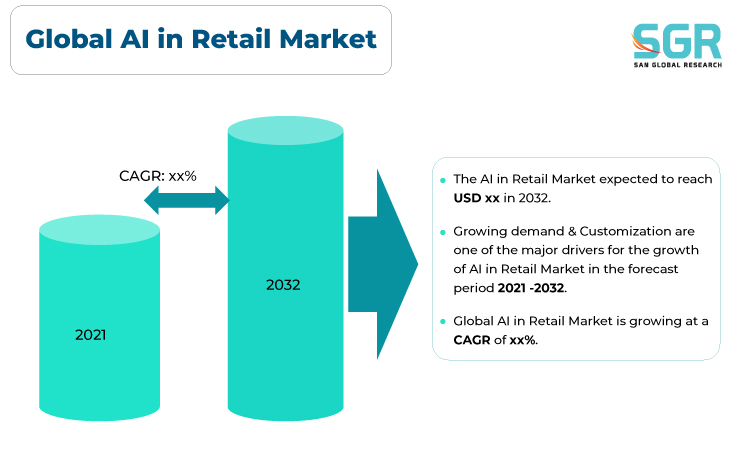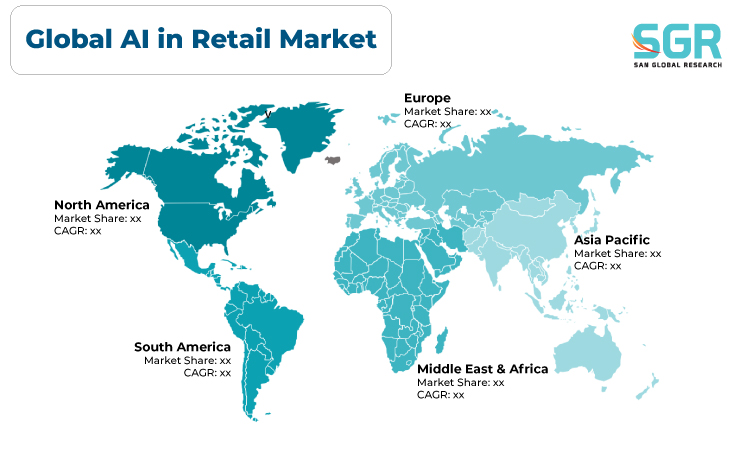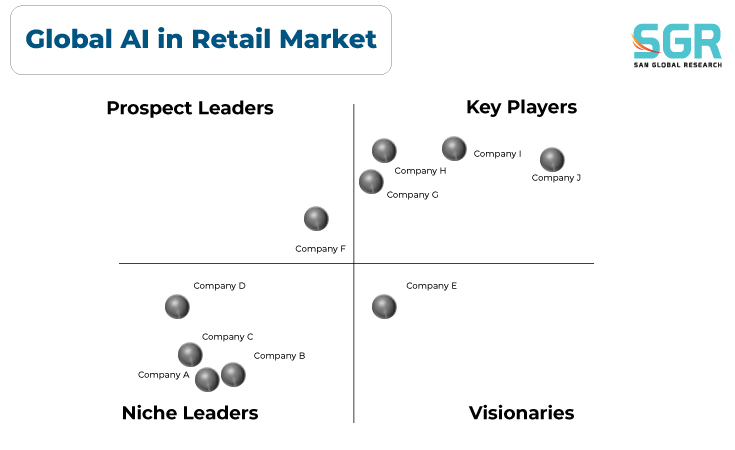Global AI in Retail Market is estimated to be worth USD 5.2 Billion in 2022 and is projected to grow at a CAGR of 28.6% between 2023 to 2032. The study has considered the base year as 2022, which estimates the market size of market and the forecast period is 2023 to 2032. The report analyzes and forecasts the market size, in terms of value (USD Billion), for the market. The report segments the market and forecasts it by offering, by function, by type, by application and region/country.

The global AI in retail market has witnessed substantial growth, driven by the integration of artificial intelligence (AI) technologies to transform various aspects of the retail industry. AI has revolutionized the retail landscape, offering advanced analytics, predictive capabilities, and personalized customer experiences. Retailers leverage AI-powered tools for demand forecasting, inventory management, and supply chain optimization, thereby improving operational efficiency and reducing costs. AI-driven recommendation systems and personalized marketing strategies enhance customer engagement and satisfaction, leading to increased sales and customer loyalty. Additionally, AI-powered chat bots and virtual assistants streamline customer service, providing instant support and personalized assistance to shoppers. The adoption of AI in retail continues to expand, enabling retailers to harness data-driven insights, optimize business processes, and adapt to changing consumer preferences, fostering a more competitive and customer-centric retail environment.

Region wise Comparison:
North America, particularly the United States, leads in AI adoption within the retail sector. Retail giants and smaller businesses alike integrate AI-driven solutions for personalized customer experiences, inventory management, and data analytics. The region's innovative retail market emphasizes AI technologies to enhance operational efficiency and customer engagement.
Europe showcases a growing AI adoption in retail, with countries like the United Kingdom, Germany, and France leveraging AI for personalized marketing, supply chain optimization, and improving the overall shopping experience. European retailers focus on AI solutions to cater to evolving consumer demands and enhance competitiveness.

The Asia-Pacific region, including countries such as China, Japan, and South Korea, demonstrates increasing interest in AI applications within the retail sector. Retailers leverage AI for inventory management, customer analytics, and omni channel strategies to meet the demands of tech-savvy consumers and enhance operational efficiencies.
Latin America's adoption of AI in retail is gradually increasing, with countries like Brazil and Mexico exploring AI-driven solutions for customer engagement, supply chain optimization, and personalized shopping experiences. Retailers aim to improve efficiencies and customer satisfaction through AI integration.
Africa's AI in retail market is in the early stages of adoption compared to other continents. However, certain regions show potential for AI implementation in retail operations, focusing on enhancing customer experiences and streamlining operations.

Segmentation:
The Global AI in Retail Market is segmented by offering, by function, by type, by application and region/country.
By Offering:
- Based on the Offering, the Global AI in Retail Market is bifurcated into Solution & Services – where the Solution is dominating and ahead in terms of share.
- AI-powered recommendation engines stand out as a pivotal solution, leveraging machine learning algorithms to offer personalized product recommendations tailored to individual consumer preferences. Additionally, predictive analytics solutions assist retailers in demand forecasting, inventory optimization, and pricing strategies, enabling more informed decision-making and efficient supply chain management. Chat bots and virtual assistants equipped with natural language processing (NLP) capabilities provide seamless customer support, answering queries, facilitating purchases, and enhancing engagement. Computer vision technologies enable visual search capabilities, allowing customers to find products via images, enhancing convenience and user experience.
By Function:
- Based on the functions, the Global AI in Retail Market is bifurcated Operations Focused and Customer Facing – where Operations Focused is dominating and ahead in terms of share.
By Type:
- Based on the Type, the Global AI in Retail Market is bifurcated into Online & Offline – where the Online is dominating and ahead of others in terms of share.
By Application:
- Based on the Application, the Global AI in Retail Market is bifurcated into Predictive Analysis, In store visual Monitoring, CRM, Market Forecasting, Inventory Management and others – where the Predictive Analysis is dominating and ahead of others in terms of share.

On the basis of region
- North America
- Europe
- Asia Pacific
- South America and
- Middle East and Africa
In 2022, North America is anticipated to dominate the Global AI in Retail Market with market revenue of XX USD Million with a registered CAGR of XX%.
Key Players:
The key market players operating in the Global AI in Retail Market include
- AMAZON
- IBM
- INTEL
- MICROSOFT
- NVIDIA
- ORACLE
- SAP
- SALESFORCE
- TALKDESK
Drivers:
Growing sector across the globe
The Global AI in retail market is propelled by several key drivers, each shaping the landscape of retail by leveraging advanced technology. One of the primary drivers is the increasing demand for personalized customer experiences. Retailers harness AI-driven tools to analyze vast amounts of consumer data, enabling them to offer personalized recommendations, targeted marketing campaigns, and tailored shopping experiences. Additionally, the need for enhanced operational efficiency acts as a catalyst for AI adoption in retail. AI-powered solutions optimize inventory management, streamline supply chains, and automate routine tasks, allowing retailers to improve efficiency and reduce costs. Moreover, the proliferation of digital commerce and e-commerce platforms has accelerated the adoption of AI in retail. Retailers utilize AI to enhance online shopping experiences, implement chat bots for customer service, and provide virtual try-on options, meeting the evolving demands of tech-savvy consumers. The continuous innovation in AI technologies, coupled with the quest for competitive advantages and the growing acceptance of AI-driven solutions in retail, further drives the market's growth and adoption across the industry.
Opportunity:
Evolving Market
The Global AI in retail market presents a myriad of opportunities shaped by the ever-evolving landscape of consumer behavior, technology advancements, and industry trends. One significant opportunity lies in leveraging AI to create hyper-personalized shopping experiences. Retailers can harness AI-driven analytics to understand individual customer preferences, anticipate needs, and offer tailored product recommendations, thereby enhancing customer engagement and loyalty. Furthermore, the integration of AI-powered solutions in supply chain management offers opportunities for enhanced efficiency and agility. Predictive analytics and demand forecasting enable retailers to optimize inventory levels, reduce stock outs, and improve overall operational resilience. Additionally, AI-driven automation of routine tasks and customer service through chat bots and virtual assistants streamlines operations, enabling retailers to focus on high-value activities and foster seamless customer interactions. Moreover, the amalgamation of AI with emerging technologies like augmented reality (AR) and virtual reality (VR) opens doors for immersive shopping experiences and innovative retail models.


 Description
Description
 Gera Imperium Rise,
Gera Imperium Rise,  +91 9209275355
+91 9209275355


